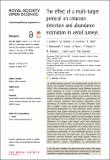Files in this item
The effect of a multi-target protocol on cetacean detection and abundance estimation in aerial surveys
Item metadata
| dc.contributor.author | Lambert, C. | |
| dc.contributor.author | Authier, M. | |
| dc.contributor.author | Dorémus, G. | |
| dc.contributor.author | Gilles, A. | |
| dc.contributor.author | Hammond, P. | |
| dc.contributor.author | Laran, S. | |
| dc.contributor.author | Ricart, A. | |
| dc.contributor.author | Ridoux, V. | |
| dc.contributor.author | Scheidat, M. | |
| dc.contributor.author | Spitz, J. | |
| dc.contributor.author | Van Canneyt, O. | |
| dc.date.accessioned | 2019-10-28T09:30:02Z | |
| dc.date.available | 2019-10-28T09:30:02Z | |
| dc.date.issued | 2019-09-04 | |
| dc.identifier | 262430928 | |
| dc.identifier | 9bb66469-c509-43a4-8f1d-15eb83648d23 | |
| dc.identifier | 85073240276 | |
| dc.identifier | 000488745800015 | |
| dc.identifier.citation | Lambert , C , Authier , M , Dorémus , G , Gilles , A , Hammond , P , Laran , S , Ricart , A , Ridoux , V , Scheidat , M , Spitz , J & Van Canneyt , O 2019 , ' The effect of a multi-target protocol on cetacean detection and abundance estimation in aerial surveys ' , Royal Society Open Science , vol. 6 , no. 9 , 190296 . https://doi.org/10.1098/rsos.190296 | en |
| dc.identifier.issn | 2054-5703 | |
| dc.identifier.other | RIS: urn:F00210C136FA28F61F17BF7C025E2BDF | |
| dc.identifier.other | ORCID: /0000-0002-2381-8302/work/64033614 | |
| dc.identifier.uri | https://hdl.handle.net/10023/18784 | |
| dc.description | This work has been funded by the French ministry in charge of the environment (Ministére de la Transition Écologique et Solidaire). | en |
| dc.description.abstract | A double-platform protocol was implemented in the Bay of Biscay and English Channel during the SCANS-III survey (2016). Two observation platforms using different protocols were operating on board a single aircraft: the reference platform (Scans), targeting cetaceans, and the ‘Megafauna’ platform, recording all the marine fauna visible at the sea surface (jellyfish to seabirds). We tested for a potential bias in small cetacean detection and density estimation when recording all marine fauna. At a small temporal scale (30 s, roughly 1.5 km), our results provided overall similar perception probabilities for both platforms. Small cetacean perception was higher following the detection of another cetacean within the previous 30 s in both platforms. The only prior target that decreased small cetacean perception during the subsequent 30 s was seabirds, in the Megafauna platform. However, at a larger scale (study area), this small-scale perception bias had no effect on the density estimates, which were similar for the two protocols. As a result, there was no evidence of lower performance regarding small cetacean population monitoring for the multi-target protocol in our study area. Because our study area was characterized by moderate cetacean densities and small spatial overlap of cetaceans and seabirds, any extrapolation to other areas or time requires caution. Nonetheless, by permitting the collection of cost-effective quantitative data for marine fauna, anthropogenic activities and marine litter at the sea surface, the multi-target protocol is valuable for optimizing logistical and financial resources to efficiently monitor biodiversity and study community ecology. | |
| dc.format.extent | 17 | |
| dc.format.extent | 1633351 | |
| dc.language.iso | eng | |
| dc.relation.ispartof | Royal Society Open Science | en |
| dc.subject | double-platform protocol | en |
| dc.subject | Abundance estimation | en |
| dc.subject | Distance sampling | en |
| dc.subject | Perception bias | en |
| dc.subject | Aerials surveys | en |
| dc.subject | SCANS-III survey | en |
| dc.subject | QH301 Biology | en |
| dc.subject | DAS | en |
| dc.subject | SDG 14 - Life Below Water | en |
| dc.subject.lcc | QH301 | en |
| dc.title | The effect of a multi-target protocol on cetacean detection and abundance estimation in aerial surveys | en |
| dc.type | Journal article | en |
| dc.contributor.institution | University of St Andrews. School of Biology | en |
| dc.contributor.institution | University of St Andrews. Sea Mammal Research Unit | en |
| dc.contributor.institution | University of St Andrews. Scottish Oceans Institute | en |
| dc.contributor.institution | University of St Andrews. Centre for Research into Ecological & Environmental Modelling | en |
| dc.contributor.institution | University of St Andrews. Marine Alliance for Science & Technology Scotland | en |
| dc.identifier.doi | https://doi.org/10.1098/rsos.190296 | |
| dc.description.status | Peer reviewed | en |
This item appears in the following Collection(s)
Items in the St Andrews Research Repository are protected by copyright, with all rights reserved, unless otherwise indicated.

